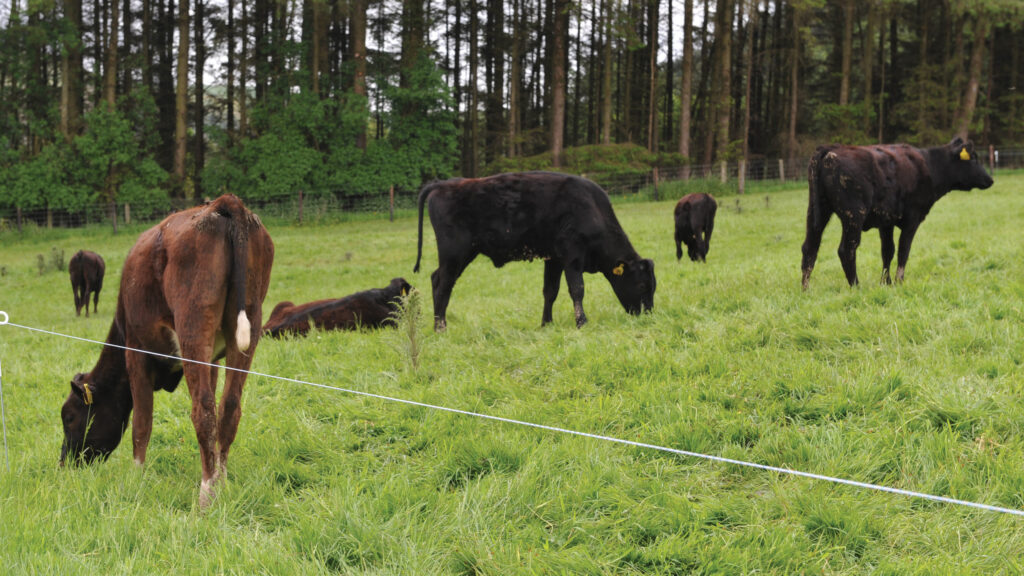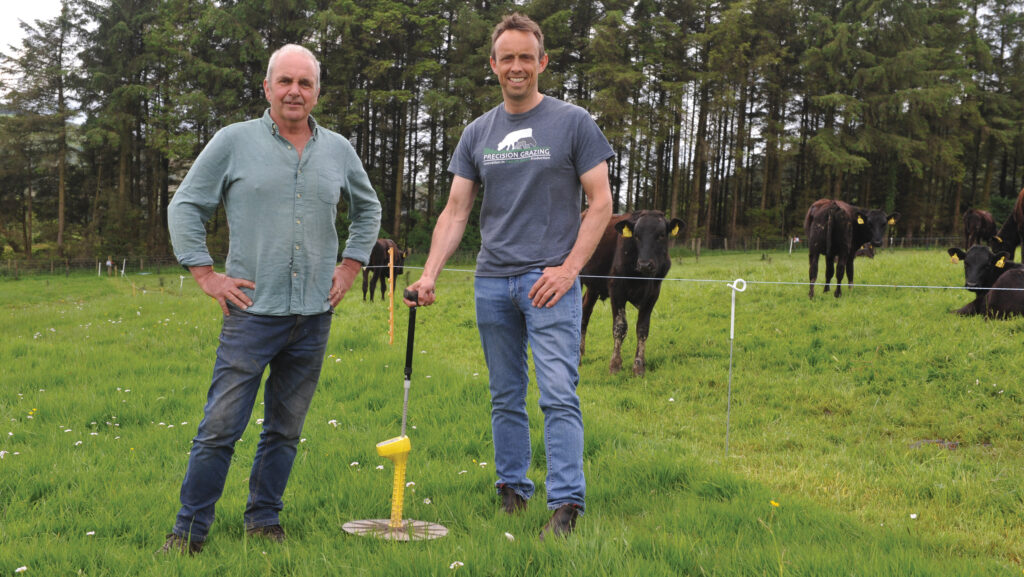Benefits of cell grazing for efficiency and farm succession
 © Debbie James
© Debbie James Succession planning has prompted a Welsh upland farm to switch from suckler beef production on a set stocking system, to growing Wagyu cattle on an intensive form of rotational grazing.
The Evans family have been farming beef and sheep at Hafod y Foel in South Montgomeryshire since 1967.
Until 2023, the enterprise centred on suckler beef from Limousin cross Welsh Blacks, but safety was a concern.
See also: Why cell grazing beat set stocking in Devon trial
Farm facts: Hafod y Foel, Llanbrynmair, South Montgomeryshire
- 174ha farmed
- 800 ewes
- 1,651mm average annual rainfall
- Clay loam and peaty soils
“When they calved, all they seemed to want to do was try to kill you,” admits Edward Evans.
He farms with his wife, Sue, and their three daughters, Elin, Manon and Cadi. The two youngest are keen to farm and this prompted the system change.
“Safety was a concern, I didn’t want the girls working with wild, big cattle,” says Edward.
The 50-cow herd was sold and they now grow cattle on contract for Warrendale Wagyus, with 80 on farm at any one time.
The first group of 40 weanlings arrived in August 2023 and the second in May. They will be reared until 21 months, then moved onto finishing farms.
Growth from grazing
The Evans family wanted daily liveweight gains to come predominately from grazed grass, so they set up a cell grazing system.
With support from Farming Connect as an “Our Farms” project, Precision Grazing was commissioned to survey, design and install the system.
Semi-permanent electric fences were used to construct lanes in two areas covering 14ha (35 acres) in total – one for weanlings and the other for yearlings.
Fields were selected not only on size, but also on location and ease of access to handling and weighing facilities.
For growing animals, daily liveweight gain is the main key performance indicator, says Precision Grazing’s Rhys Williams, so there needs to be regular weighing.

Edward Evans (left) and Rhys Williams © Debbie James
Lanes are sub-divided into cells with temporary electric fencing, and the size of the cells determined by the grazing demand of the livestock, the supply of grass, and the desired grazing “on-time” (the length of time livestock graze an area).
“Ideally you should be looking for even numbers of lanes to form a rotation, easing the movement of livestock through the system,” Rhys explains.
Cells on rotation
Although both grazing areas are sub-divided into 16 cells, the lane system allows for an increase or decrease in the number as required, depending on mob size, stage of production and grass growth.
Individual grass demand for a growing animal is equivalent to 2.5% of the animal’s liveweight, for example, a weanling weighing 150kg, has a daily demand of 3.75kg dry matter (DM).
Group demand for the 40 weanling cattle is 150kg DM/day.
“The total area of their rotation is 4.6ha giving a demand a hectare of 33kg DM/ha.
“This means that [the grazing area] needs to grow 33kg DM/ha a day to maintain the group of 40 weanlings on the rotation,” says Rhys.
Entry covers averaging 2,500kg DM/ha are targeted for this class of cattle and once fully transitioned onto grass, the aim is to graze down to a residual of 1,500kg DM/ha.
The more mature yearling cattle group can utilise higher covers and are able to thrive on 3,000kg DM/ha, says Rhys.
Flexibility is key to the layout of the grazing infrastructure because the animals are growing, so grass demand is fluid.
Cell size can therefore be adjusted according to grass supply and livestock demand.
The target is for grazing on-time to be no longer than three days, as the shorter time leads to higher grass utilisation.
When designing a cell grazing system, Rhys says farmers have to work with their field layout, but his advice is to make cells as square as possible to avoid livestock congregating, or walking up and down the narrow areas.
Ideally, the cells form a rotation with stock always moving forward to the next cell.
“[Also], the last cell needs to be next to the first cell to be grazed in the following rotation, to follow the logical sequence of the rotation,” Rhys adds.
Water supply
Establishing a sufficient water supply is essential and needs to be done before anything else in the design process, he says.
Access to drinking water was a limiting factor for grazing on the farm, as natural watercourses were the main source of supply for livestock.
To overcome this, the family drilled a borehole with 40% of its cost met by the Welsh government’s Small Grants – Efficiency scheme.
Water pipes were laid with hydrants servicing every four cells.
Portable troughs (easily emptied and towed by hand or behind a vehicle) are moved from cell to cell with the cattle, and connected to the water pipes via a special hydrant.
Grass is measured with a rising plate meter every fortnight and the data entered into a pasture-based modelling programme, which calculates the DM requirement of the animals and models it against a prediction for grass availability.
This allows the stocking rate, rotation length and target kg of liveweight of production to be established.
Edward says grass utilisation has improved – although there are no previous figures to measure it against, he is confident that production in these fields has doubled and is of a higher quality.
“If the grass growth is getting ahead of us, we can graze some of the cells with sheep or take them out for silage, to maintain grass quality, and we can also plan for any deficits,” he says.
Fertiliser cut
Applications of ammonium nitrate fertiliser have also been cut out from the grazing fields – saving around 25t a year – only lime and farmyard manure are now applied.
This approach has corrected a pH deficit.
Soil sampling funded by Farming Connect showed an average pH 5 across the farm, but lime applications have increased it to more than pH 6, which has helped the farm grow more grass.
The Evans also produce lamb from a flock of Welsh and Aberfield ewes and have made changes to this system too, lambing a month earlier at the beginning of March.
Sales of lambs can start in June, capturing stronger prices.
“Getting the lambs gone quicker means that they are not still on the farm in October and November, when we had been trying to get rid of them as stores,” says Edward.
By growing more grass in summer, grazing can be deferred to early autumn as feed for ewes, so less silage is needed for the flock.
To improve future resilience, Edward has planted hedgerows as shelter for livestock.
Introducing the changes has improved Edward’s outlook, and his advice to others considering cell grazing is to do it in changes.
“Start off small and slowly, and then scale up. I am enjoying farming now more than ever – we are seeing results of what we are doing, and growing more grass.”
